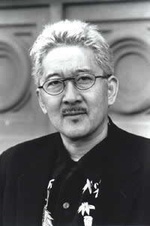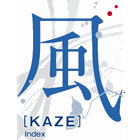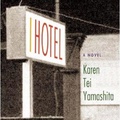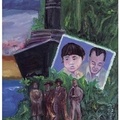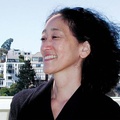日系を含めたアジア系アメリカ演劇は、日本出身の俳優、マコ・イワマツがロサンゼルスで劇団イースト・ウェスト・プレーヤーズ(EWP)を創設した1965年に始まった。8年後の1973年には、サンフランシスコでアジアンアメリカン・シアター・カンパニー(AATC)が旗揚げされ、サンフランシスコ出身の日系3世、フィリップ・ゴタンダは西海岸にできたこの2つの劇団に深く関わるようになる。
表現の場を音楽から舞台へ
ゴタンダの祖父母は広島県出身。母方の祖父は渡米して中西部の鉄道で働き、その後カリフォルニアのストックトンに落ち着いた。父方の祖父はハワイに移住し、フィリップの父、ウィルフレッド・イツタ・ゴタンダも13人兄弟と共にハワイに生まれ育ったが、本土で医学を学んだ後ストックトンで開業した。ウィルフレッドは、この地で教師をしていたキャサリン・マツモトと出会い、結婚した。新婚生活が始まったばかりの時に第2次大戦がはじまり、2人はアーカンソー州のローワー収容所に送られた。戦後、ストックトンに戻り、1951年にフィリップが生れた。
50年代から60年代にかけて、フィリップは圧倒的に白人が多い地域で育った。日系アメリカ人の視点でものを見ることが考えられない時代であり、環境だった。物心がついた頃から彼は、自分のなかにある芸術的な部分と真面目な部分を認識していた。その2つの面の「揺れ」の中で、彼は13歳の時にギターを手にし、作曲をし、バンドをつくり、音楽に夢中になった。
60年代後半になると、アメリカでベトナム反戦運動や黒人による公民権運動がおこる。「アジア系アメリカ人」という概念がつくられ、彼らをとりまく状況は、そういった社会情勢と相まって一変する。大学生の時にちょうどこの渦の中に巻き込まれたゴタンダは、イエローパワーや人種差別主義などの考え方に、ついていくことができなかった。学生のストライキで授業に出ることもままならなくなった。そんな時、日本への交換留学プログラムの話が持ち上がり、彼はそれに参加して日本で自分を見つめなおすことにしたのである。1970年のことだった。
当初は日本になじめなかったが、やがて日本文化、とりわけ陶器に興味を持つにいたり、ゴタンダは栃木県の益子で陶芸を学ぶ。そして外見が同じ日本人の中で暮らすことがいかに心地よく、心理的負担がないかを実感する。だが、一方で自分がアメリカ人であることを再認識し、新たなビジョンを持ってアメリカに戻ることになる。この滞日体験は、ゴタンダに大きな影響を与え、戯曲でもその当時の体験が時々現れる。
アメリカに戻り、カリフォルニア大学サンタバーバラ校に入学した彼は、アジア系アメリカ人運動の文化的側面に関心を持ち、日系詩人のローソン・イナダ、フィリピン系詩人のジェシカ・ヘゲドン、日系で音楽活動をしていたクリス・イイジマ、ノブコ・ミヤモトやジャズバンドの「ヒロシマ」などから刺激を受ける。ハイスクールのころから音楽に親しんでいたゴタンダは、73年に大学を卒業した後もシンガー・ソング・ライターを続け、自分のアイデンティティを歌に込めてさまざまな場所でうたっていた。歌手として「ヒロシマ」のオーディションを受けたこともある。結局は「ヒロシマ」には加わらなかったが、これがきっかけで同バンドリーダーのダン・クラモトとの親交がはじまった。
こうしたクリエイティブな活動をしながらも、ゴタンダは、もうひとつの「堅実な面」を持続していた。75年にロースクールに入学し、78年に法律の学位を取得している。小さい時からの「揺れ」がこの時まで続いていた。医師だった父親の影響もあったのかもしれない。しかし、この後、彼は敢然と芸術に向かっていく。それも、歌ではなく、舞台に表現の場を求めた。彼自身の言葉を借りれば、自分の歌をうたっているだけでは満足できなくなってしまったのだ。
「The Avocado Kid(アボカド・キッド」」という日本の桃太郎をベースとしたロック・ミュージカルを書き、ロサンゼルスのEWPで上演され、評判になった。1979年のことである。ちょうど、アジア系アメリカ人の劇団がアジア系アメリカ人の手による新しい戯曲を求めていたときで、ゴタンダの登場はそんな状況に合致していた。
これまで、ゴタンダは20本ほど戯曲を発表しているが、現在はアジア系の小劇場のみならず、ボストンのハンチントン劇場や、ニューヨークのマーク・テイパー・フォーラムなどの大劇場、さらにはイギリスや日本でも彼の作品は上演されている。日本ではこれまで、「The Wash」「A Song for a Nisei Fisherman」「Sisters Matsumoto」の3作品が、それぞれ、「ザ・ウォッシュ」「太公望のひとりごと」「マツモト・シスターズ」のタイトルで上演されている。まずは、この3本の戯曲を紹介したい。
*本稿は、時事的な問題や日々の話題と新書を関連づけた記事や、毎月のベストセラー、新刊の批評コラムなど新書に関する情報を掲載する連想出版のWebマガジン「風」 のコラムシリーズ『二つの国の視点から』第5回目からの転載です。
© 2009 Association Press and Tatsuya Sudo


